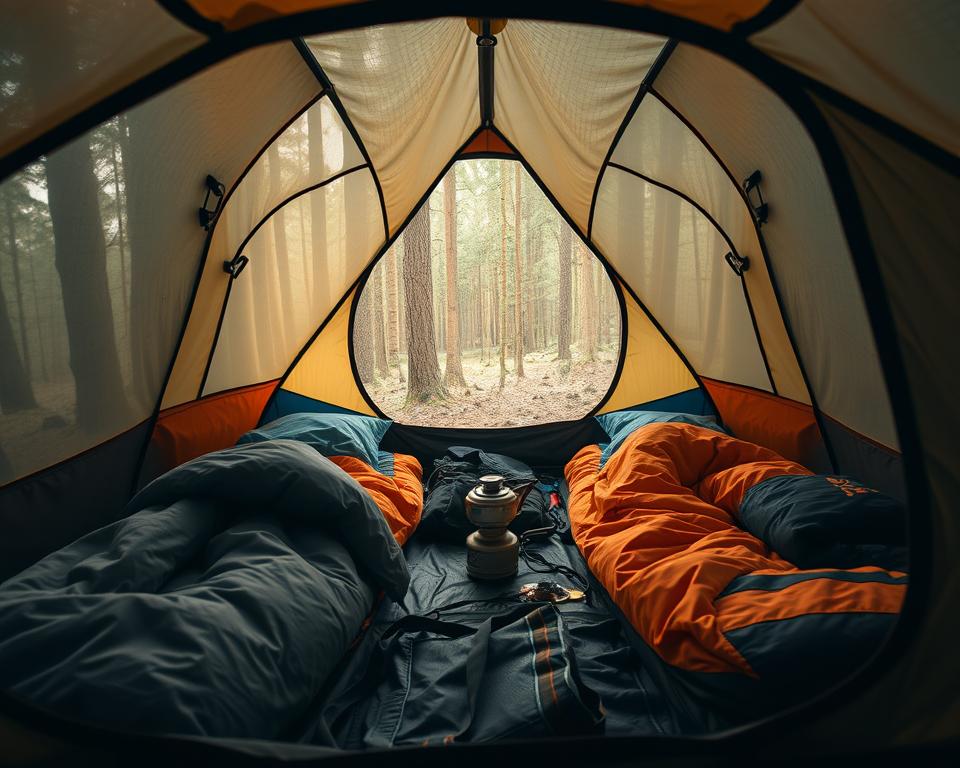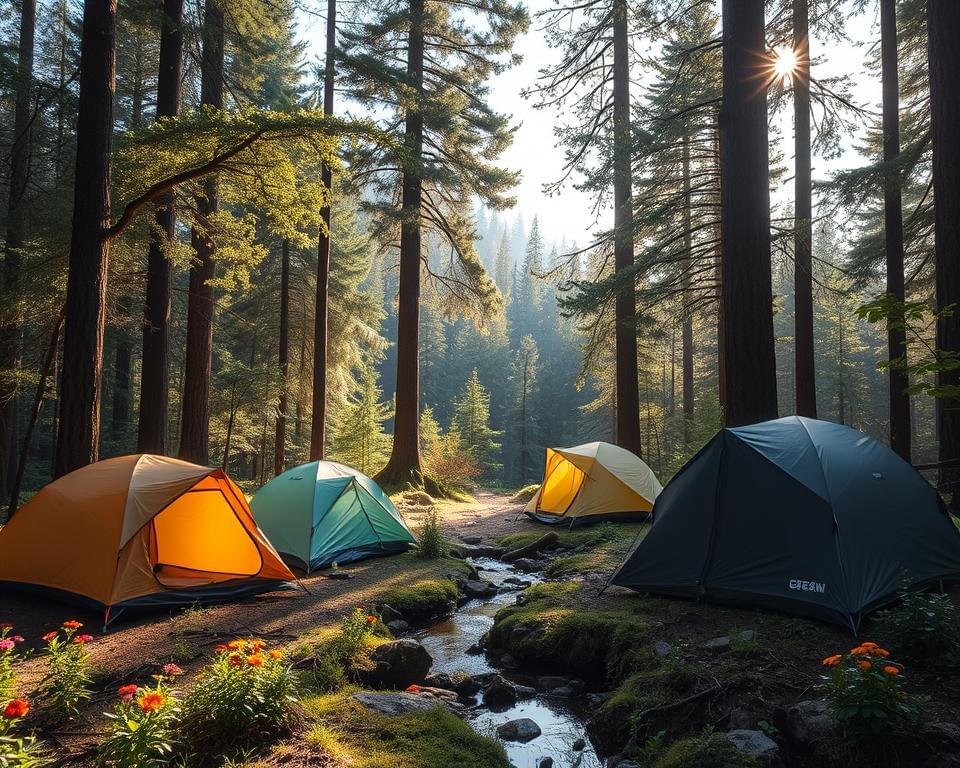Finding the right backpacking tent is essential. It is your home while you explore the outdoors. There are many choices, from budget tents to ultralight ones for serious hikers. We will look at how to choose the perfect tent for adventure.
Your tent is key for comfort and safety in the wild. Most backpackers use 3-season tents because they travel mostly in summer. Ultralight tents, weighing two pounds or less, are great for long distances or thru-hiking.
Tent prices vary, from $200 for basic models to $800+ for light ones. Durability matters for longevity and coping with weather. Two-person tents are popular, but three-person tents offer more room for small families or those wanting extra space.
Choosing involves looking at weight, cost, size, and durability. Always check the latest guides for quality backpacking tents. Good tents make your hikes and long trips better, ensuring fun and safety.
Understanding Tent Seasonality
Choosing the right tent is key for a great backpacking adventure. It all starts with knowing about camping seasonality. Different tents work best in different kinds of weather. We’ll look at three-season and four-season tents to help you choose wisely.
3-Season Tents
Most backpackers like 3-season tents for camping from late spring to early fall. These tents have mesh panels for good airflow. They can also handle wind and rain well. They’re great for summer camping.
If you’re camping in the early spring or late fall, or if it’s very windy, think about getting a stronger 3-season tent.
4-Season Tents
4-season tents are for winter camping or when you expect heavy snow. They’re made to protect you from extreme weather. They use tough materials and have strong poles. 4-season tents have less mesh to keep you warm and stop snow from getting inside.
Weather Considerations
It’s important to think about the weather for your backpacking trip. 3-season tents are good for most conditions. But, if you’re going somewhere with very tough weather, you’ll need a 4-season tent. Make sure your tent matches the weather to stay safe and have fun.
Assessing Your Backpacking Needs
Knowing your backpacking style is key when choosing a tent. Each type, from casual trips to intense expeditions, needs different features.
Casual Backpacking
Casual backpacking is great for short trips, like weekends or holidays. The focus is on tents that are easy to set up and durable. These tents are budget-friendly and perfect for the occasional adventure.
It’s important to have a tent that’s easy to carry and set up quickly. This makes overnight hikes more enjoyable.
Serious Backpacking
Longer, tougher trips require light tents that pack small. Every ounce counts in long-distance backpacking. Serious backpackers look for tents that are light yet comfortable.
These tents use advanced materials and design. They offer good space, weather resistance, and are durable, all while being lightweight.
Thru-Hiking
Thru-hiking takes backpacking to the extreme. For these long adventures, gear must be ultralight and efficient. Thru-hikers need ultralight tents, sometimes under three pounds, to make carrying everything easier.
These tents balance minimal weight with the essentials needed on the trail. They are perfect for those focusing on low weight and efficiency.
Choosing the right tent for your backpacking style ensures your shelter fits your needs. Whether it’s a casual trip, a serious expedition, or a thru-hike, the right tent makes all the difference.
How to Choose a Tent for Backpacking
Choosing the right tent for your backpacking trip is crucial. It affects your trail experience. Things like weight, cost, and how the tent works are important to think about. Knowing these things helps you pick the best tent for you.
Tent Weight
The tent’s weight matters a lot for backpacking. If you’re walking far, lightweight backpacking tents ease shoulder strain. Basic tents weigh around 4 to 5 pounds. But, ultralight models may only be about 2 pounds. It’s key to balance weight with features to suit your hiking style.
Cost Considerations
Setting a budget for your tent is key. Prices vary, from $200 to over $800 for light tents. For beginners or casual hikers, affordable hiking tents are a good start. They offer a mix of price and needed features for shorter trips.
Spending more on a tent often gets you more comfort and lasts longer. It’s a good idea for those who hike a lot. Yet, find a tent that matches what you need and what you can spend. Look at different tents, thinking about cost now and their value later on.
Tent Capacity and Livable Space
Choosing the right tent for your adventure is key. Backpacking tents usually fit one to four people. The most common are for two or three people. Thinking about upsizing is smart if you’re not going solo. Extra space means more comfort, especially with a buddy or pet.

Look at a tent’s floor area to pick the right size. It’s measured in square footage or by length and width. About 14 square feet per person should do. For two people, a 2-person tent fits two regular sleeping pads perfectly. If you need more room, consider a 3-person tent.
Solo hikers find one-person tents just right. They offer enough space without the extra weight. For families, larger tents ensure everyone has room to sleep and store gear.
Consider tent peak height for activities besides sleeping. Tents with vertical walls give you more space to move around. They’re great for long trips. Your backpacking tent’s size should balance weight and comfort, depending on your trip type and hiker size.
Beware that tent capacity might not always be accurate. It can lead to a tighter fit than expected. For example, the REI Half Dome 2 Plus is spacious and true to size. But, it’s heavier. Upsizing to a 3-person tent gives two people more room and comfort.
Selecting the right tent size needs thought on many things. Think about how many people will use it, the weather, and what’s comfortable for you. Taking time to consider all these can make your trip much better.
Comparing Freestanding and Non-Freestanding Tents
Choosing the right tent for your backpacking trip is vital. Freestanding and non-freestanding tents differ a lot. Understanding these differences helps you pick the best one for your needs.
Freestanding Tents
Freestanding tents are loved by many campers and Appalachian Trail hikers. They are easy to set up anywhere. Their pole system makes them stand without help. You can place them exactly where you want before making them secure.
Models like the Big Agnes Fly Creek UL2 offer lots of room and good airflow. Their double-wall design lessens inside condensation. These tents stand firm on hard-to-pitch surfaces like deserts or rocky grounds. Though they weigh more, they bring comfort, durability, and more space. This makes them perfect for those who value comfort over carrying less weight.
Non-Freestanding Tents
Non-freestanding tents suit ultralight backpackers and advanced hikers. They are lighter because they use stakes for structure. Though setting up can be hard at first, you’ll get faster with practice.
These tents do well against wind and rain if set up right. They have less room inside but are incredibly light. For those who want to carry less and still have protection, non-freestanding tents are great.
Additional Tent Features to Consider
Choosing the right tent isn’t just about the basics. You should also think about extra features that can make camping more comfortable and convenient. Here are some things to keep in mind:
Number of Doors
When camping with others, the number of tent doors matters. Tents with more than one door can really improve your camping experience. They help everyone get in and out easily. This is super helpful for those late-night trips outside.
Vestibules and Interior Pockets
Vestibules give you extra space outside the sleeping area. This space is perfect for storing gear, wet clothes, or dirty boots. It keeps the inside of your tent clean and roomy. On the inside, pockets help keep small items like lights, maps, and snacks organized. This way, you know where everything is.
Ventilation and Condensation Control
Good backpacking tent ventilation helps prevent condensation inside the tent. If moisture builds up, sleeping can get uncomfortable and damp. Tents with mesh areas, big windows, or vents can help keep things dry. Focusing on these aspects can be especially helpful during long or humid trips.
Finding the perfect tent means looking at more than just the basics. Consider things like door number, tent storage solutions, and backpacking tent ventilation. These features can help you make a good decision and improve your camping trips. They make sure you have a cozy, organized, and dry spot in the great outdoors.
Material Quality and Durability
Choosing the right tent involves looking at tent material durability. The fabric of your tent affects how well it works and how long it lasts. Knowing about different materials and maintenance can give you a dependable shelter for your backpacking trips.
Types of Materials
Backpacking tents are made from various fabrics, each with pros and cons:
- Polyester and Nylon: These are chosen for being light and not too expensive. High denier counts mean more strength. They often have waterproof coatings like PU or SilNylon.
- Dyneema Tents: Known too as Cuben Fiber, Dyneema tents shine for their strength while being very light. They are durable and resist bad weather well, making them perfect for avid backpackers.
Maintenance Tips
Keeping your tent in great shape is key to its longevity. Here’s how to care for your tent:
- Cleaning: Wash your tent with mild soap and a soft sponge. Stay away from strong chemicals that can harm waterproof coatings.
- Storage: Store your tent in a place that’s cool and dry. Be sure it’s dry before packing to avoid mold and mildew.
- Repairs: Have a repair kit ready for quick fixes and mend tears fast to prevent more damage. Use the right products for fixing Dyneema tents for the best repair.
By following these maintenance tips and learning about tent materials, you can make your tent last longer. Enjoy many outdoor adventures with a well-cared-for tent.
How Can Proper Tent Storage Techniques Enhance the Longevity of the Tent I Choose for Backpacking?
Proper tent storage techniques are essential for preserving the longevity of your backpacking equipment. By following effective tips for tent folding and storage, you can minimize wear and tear, prevent mold growth, and ensure your tent is always ready for the next adventure. Careful handling pays off in durability and performance.
Conclusion
Picking the right tent means balancing many factors. This guide helps you choose carefully, focusing on backpacking tent needs. You learned about tent seasonality and the differences between freestanding and non-freestanding tents. Each detail affects your backpacking.
Three-season tents work well for spring to fall, and most backpackers like them. But, four-season tents are better for cold winter. Choosing between dome or tunnel tents affects your comfort and space. Also, materials matter. For example, ripstop nylon is durable, and a waterproof rainfly is key for bad weather.
Materials like silicon nylon for air flow and carbon fiber poles for lightness are vital for serious backpackers. Freestanding tents are easy to move, but non-freestanding tents need stakes and careful setup. Thinking about these points helps you pick the right tent. With this guide, you’re ready to find a tent that’s safe, reliable, and comfortable for your adventures.

